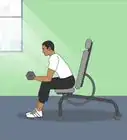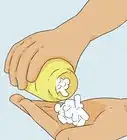This article was co-authored by Pete Cerqua. Pete Cerqua is a Certified Personal Trainer and Nutritionist. Pete is also a five-time best-selling author of books including "The 90-Second Fitness Solution" and "High Intensity Fitness Revolution for Women/Men" published by Simon and Schuster and Skyhorse Publishing. Pete has over 20 years of personal training and nutrition coaching experience and operates the 90-Second Fitness flagship studio in New York City.
There are 12 references cited in this article, which can be found at the bottom of the page.
wikiHow marks an article as reader-approved once it receives enough positive feedback. This article has 14 testimonials from our readers, earning it our reader-approved status.
This article has been viewed 600,236 times.
Are you unsatisfied with your arms? Are they weak, flabby, or scrawny? Do you want big, lean arms and do you want them now? While it's impossible to achieve any sort of muscle growth instantaneously, with hard work and smart exercise strategies, you can start seeing noticeable results in as little as a few weeks to a month.
Steps
Arm Workout Schedule
There's no single "right" way to get big arms, but the sample workout plans below should offer a well-balanced path that targets the whole upper body — not just the biceps or triceps. For maximum effectiveness, leave one day of rest between each day's workout and leave two days of rest after Day Three before cycling back to Day One for a balanced weekly schedule. Use your four "off" days to target other muscle groups like your core, back, and lower body (or to rest.)
| Exercise | Time/Repetitions | Notes |
|---|---|---|
| Stretches | 10-15 minutes | If desired, substitute yoga or other flexibility-building exercises. |
| Cardio warmup | 5-10 minutes | Jogging, biking, etc. work well. Aim to hit a heart rate of roughly 115 bpm for greater strength while lifting.[1] |
| Barbell Curl | 10-15 repetitions; 3-4 sets | |
| Hammer Curl | 10-15 repetitions; 3-4 sets | |
| Chin-up | As many repetitions as possible; 3-4 sets | May alternatively use weighted chin-ups for an easier exercise. |
| Seated Row | 10-15 repetitions; 3-4 sets | |
| Inverted Row | 10-15 repetitions; 3-4 sets | |
| Light cardio cooldown | 5 minutes | Fast walking or gentle biking work well. Aim to gradually decrease your elevated heartrate. |
| Exercise | Time/Repetitions | Notes |
|---|---|---|
| Stretches | 10-15 minutes | See above |
| Cardio warmup | 5-10 minutes | See above. |
| Bench Press | As many repetitions as you can do safely; 3-4 sets | Use a spotter for free weights. |
| Chest Fly | 10-15 repetitions; 3-4 sets | |
| Tricep Extension | 10-15 repetitions; 3-4 sets | |
| Dips | As many repetitions as possible; 3-4 sets | May use chain/weight belts to increase difficulty. |
| Light cardio cooldown | 5 minutes | See above. |
| Exercise | Time/Repetitions | Notes |
|---|---|---|
| Stretches | 10-15 minutes | See above |
| Cardio warmup | 5-10 minutes | See above. |
| Military Press | 10-15 repetitions; 3-4 sets | May do seated or standing variant. |
| Lateral Dumbbell Raise | 10-15 repetitions; 3-4 sets | May do front, side, rear variants to target different deltoid muscle groups. |
| Overhead Lift | As many repetitions as you can do safely; 3-4 sets | Can also serve as hip/core exercise. |
| Barbell Wrist Curls | 1-2 minutes; 2-3 sets | May use reverse variant. |
| Light cardio cooldown | 5 minutes | See above. |
Hitting Major Arm Muscle Groups
-
1Plan an aggressive workout schedule. To build powerful arms, most fitness resources will recommend beginning a weightlifting regimen with plenty of upper-body exercises. Weightlifting is a form of exercise that's set at the participant's pace — the more time and energy you put into it, the better results you'll get out of it. While there's no single "correct" way build your arms through weightlifting, in general, it's wise to keep the following tips in mind for optimal results:
- Aim to lift weights most days every week. An ambitious weightlifting regimen will usually schedule weight training exercise for about five days per week, leaving two days for rest or cardio exercise. The more recent studies are showing that you can go as many as 32 sets per week and get great results. You can divide that up any way you want. You could do it all in one day and rest for six more days, or you could split it up three ways and do it three times a week.
- Try to avoid exercising the same muscle group two days in a row — to grow, muscles need time to rest and repair the damage from an exercise session. For instance, if you exercise your triceps one day, focus on your chest the next day.
- Don't focus solely on your arms. Doing so over a long period of time will give you a bizarre, lopsided appearance — beefy arms, but scrawny core and lower body muscles. A good policy is to exercise your legs and core on at least two days per week.
-
2Exercise your biceps. When it comes to getting big, muscular arms, many people have one specific muscle group in mind: the biceps. It's easy to see why this is — the stereotypical image of the body builder is a muscular man hunched over at a bench performing curls with a massive dumbbell. While the biceps aren't usually the strongest muscles in the upper body (or even in the arm), there's no denying that this muscle group is important for a variety of physical tasks, like lifting, pulling, and stabilizing heavy weights. Below are just a few exercises to help you start feeling the burn in your biceps:
- Barbell/Dumbbell Curls: Stand holding a weighted barbell (or one dumbbell in each hand) at your waist with an underhand grip. Carefully raise the weight up to chest-level as you keep your elbows tucked at your sides, then lower it. Repeat.
- Hammer Curls: This exercise targets the crucial "long head" (biceps brachii) muscle, which is responsible for the much-coveted "bump" or "peak" on the upper arm.[2] Perform as if doing dumbbell curls, but hold the dumbbells so that your palms are facing each other, rather than with an underhand grip. Your arm motion should resemble the slowed-down swinging of a hammer.
- See our biceps article for more exercises.
Advertisement -
3Hit your triceps. Though they sometimes receive less attention than their neighboring biceps muscles, the triceps are usually regarded as more important in terms of both muscle mass and overall strength.[3] Be sure to give just as much attention (if not more) to your triceps as you give to your biceps — if you want big, muscular arms, you'll be doing yourself a disservice by not doing so. Below are just a few great triceps exercises:
- Triceps Extensions: In a standing position, hold a dumbbell in both hands behind your head with your elbows bent near the sides of your head. Lift the dumbbell up and over your head, taking care not to hit the back of your head. Lower the weight back to the starting position and repeat.
- Dips: Support yourself between two parallel level bars or at the edge of a bench using your arms. Slowly lower yourself to the point where your upper arms are level with the floor, then lift yourself back up without twisting or jerking. Repeat.
- See our triceps article for more exercises.
-
4Pump up your shoulders. A broad, muscular set of shoulders is often seen as a very attractive trait. In addition, the shoulder muscles (or deltoids) are important for a variety of physical tasks like lifting, throwing, and keeping the relatively unstable shoulder joint free from injury.[4] Below are just a few shoulder exercises you may want to consider:
- Military Presses: In a standing or sitting position, bring a weighted barbell up to the chest level using a medium-wide overhand grip. Slowly raise the weight in front of your face and up over your head. Lower the bar to roughly chin level and repeat.
- Lateral Dumbbell Raises: Stand holding one dumbbell in each hand. Slowly raise your arms in an arc out to your side, leading with your elbows. When your arms are roughly parallel to the floor, slowly lower them back down and repeat. You may angle your arms forward or backward to work the front or back of your shoulders.
- Overhead lifts: This full-body exercise targets the shoulders as well as the hips, legs, and back. Standing with a weighted barbell on the floor in front of you, carefully perform a deadlift to raise it to about waist level. Lift the weight up to your chest (taking care not to use uncontrolled movements) and perform a Military Press (see above) to lift it over your head. Reverse these movements to lower the weight back to the floor and repeat.
-
5Beef up your chest. Though the chest muscles aren't technically part of your arm, strong arms look unappealing next to a flabby chest, so this area is a must for anyone interested in beefing up their arms. Plus, arm muscles like the triceps often play a supporting role in many chest exercises.[5] Though it's widely-known, the bench press isn't the only way to work out your chest — see the list below for information on this and other chest exercises:
- Bench Presses: Lay with your back flat on an exercise bench. Carefully lift a weighted barbell (or two dumbbells) up away from your chest until your arms are extended, then lower the weight back down and repeat. Be sure to use a spotter to avoid serious injury when dealing with heavy weights.
- Chest Flies: Lay on your back on the floor or an exercise bench with a dumbbell in each hand. Position each arm out to the side, then bring your arms together in front of your chest in a wide, smooth arc. Lower your arms back to their starting position and repeat — you should look a little like you're "flapping" a pair of wings.
- See our chest article for more exercises.
-
6Don't neglect your back and lat muscles. Strictly speaking, the lats (latissimus dorsi muscles) and back muscles aren't part of your arms. However, nearly every weightlifter looking to get big, muscular arms will make sure to devote time to these muscle groups as well. This is partly for aesthetic reasons (strong arms don't pair well with weak back and lat muscles), but it's also because the back and lats are supporting muscles in many exercises that are used to strengthen the arms as well. Below are just a few exercises you can do to target these important groups:
- Seated Rows: Sit on a bench in front of a horizontal cable set up or elastic band. Carefully pull the cable or band toward you, making sure to keep your back straight in an upright but slightly reclined posture. Squeeze the muscles between your shoulder blades as you complete the full range of motion. Be sure not to hunch or bend in your back as you do this exercise — this can lead to back injury.[6]
- Inverted Rows: Lay with your back on the floor under a low horizontal bar. Grab the bar and slowly pull yourself up toward it (keeping your feet on the ground) until the bar is nearly touching your chest. Lower yourself back down and repeat.
- Chin Ups/Pull Ups: There are a huge variety of exercises you can do hanging from a horizontal bar. To do a basic chin up, hold the bar with an underhand grip and slowly raise your body up to the bar until it is near your chest. Lower yourself down and repeat.
-
7Spend time on your forearms for a well-toned look. Well-toned forearms are the "cherry on top" of a chiseled upper body. Though they're important for hand and grip strength (which can be important for some athletes, like rock climbers), many weightlifters simply work out their forearms to look good. Try the simple exercise below for a basic forearm workout:
- Barbell Wrist Curls: Sit at a bench holding a weighted barbell with your forearms resting on your thighs. Raise the barbell as high as it can go using only the muscles in your hands and forearms, then let these muscles relax to let the weight hang as low as it can. Repeat. For a complete workout, try reversing your grip with each set.
Encouraging Fast Muscle Growth
-
1Consider prioritizing weight over reps. Getting your muscles tired day after day will eventually lead to increased muscle strength and growth no matter how you do it (as long as you're eating enough for your body to be able to build muscle.) However, if you're interested in big, bulky muscles, it's usually recommended that you focus on performing a few repetitions of each exercise at a high weight (rather than performing many repetitions at a low weight.) For instance, most weightlifting resources attest that, if all other factors are equal, knocking out three to six heavy reps will give you bigger muscles than doing 15-20 lighter reps.
- On the other hand, some weight trainers (including Arnold Schwarzenegger) recommend a more middle-of-the-road approach that uses medium-high resistance levels and a slightly higher number of reps (typically about 30-32 sets per week on each of the muscles.) This offers a healthy balance of strength, definition, and mass over time.
-
2Use an "explosive" approach to weightlifting. For the fastest possible muscle growth, put all of your energy into your lift! Research has shown that so-called "explosive" weightlifting — that is, weightlifting exercises where the lifter tries to lift the weight up as quickly as possible — can cause muscle (and strength) to grow faster than with an ordinary approach.[7] Explosive training helps your body "power through" weak spots in your range of motion by teaching your muscles to contract quicker, making this a valuable strategy for anyone aiming to build muscle quickly.
- However, it's always important to use good form, so don't let your goal of being "explosive" distract you from your ability to lift the weight smoothly through its full range of motion. Never use bending, twisting, or jerking motions to lift a weight — this can cause painful, long-lasting injury.[8]
-
3Consider the benefits of free weights over machines. It's possible to get big, powerful muscles with nearly any form of resistance training as long as your exercise allows you to move through a full range of motion and provides adequate challenge.[9] However, many weightlifting resources recommend free weights (like barbells, dumbbells, and so on) over exercise machines. Free weights better mimic real-life physical tasks and allow stabilizing muscles to be trained at the same time as the main muscles being isolated, making them preferable to many (though, with bad form, the potential for injury is often higher than with machines.)
- Body weight exercises (like pushups, crunches, pullups, dips, and so on) are usually considered happy middle ground — they offer lots of potential for muscle growth while keeping the risk for injury low.
-
4Avoid spending too much energy on cardio. Cardio exercise isn't bad for you — in fact, it's a great way to increase your endurance and burn calories, something that weightlifting isn't really good at — but if you're trying to build muscle, it can be counterproductive. Spending lots of energy on exercises like running, cycling, swimming, and so on reduces the amount of energy you'll have leftover to build muscle. Thus, for muscle-building purposes, you'll generally want to limit serious cardio exercise to once or twice per week at most.
- If you love cardio, consider substituting lower-intensity exercises like walking and hiking as opposed to higher-intensity ones like swimming or running.
-
5Start eating healthy. To build muscle, you've got to give your body plenty of healthy fuel for growth. In general, a muscle-building diet will be high in lean protein sources, with reasonable amounts of healthy fats and carbohydrates. Vegetables and fruits can provide much-needed vitamins and minerals, while sugary foods and overly-fatty dishes are to be kept to a minimum. Try including plenty of the following foods in your diet — ideally, you'll want to get about 40-50% of your calories from protein, 40-50% from carbs, and 10-20% from fats:[10]
- Protein: Lean meats, like chicken, turkey, most fish, egg whites, and lean cuts of pork and beef. Plant products like legumes, soy (tofu), broccoli, spinach, tempeh, and seitan can provide plenty of healthy protein. Lean dairy (like Greek-style yogurt) is also a good source of protein. Finally, many weight lifters recommend protein supplements and powders.
- Carbohydrates: Whole grain bread/pasta products, brown rice, oats, quinoa, starchy vegetables like yams and potatoes. Green and/or fibrous vegetables like broccoli, celery, peas, and so on are also good choices.
- Fats: Avocados, nuts, cheeses, and light, healthy oils (like canola and sunflower oil) can provide valuable energy and nutrients.
-
6Drink enough water every day. Water can help keep you refreshed and full of energy for your workout. Even better, it's a zero calorie way to help alleviate the cravings that can accompany a healthy new diet. Most nutrition resources recommend drinking half a gallon (about two liters) of water per day. However, with sweating and strenuous exercise, this amount can easily be more.
-
7Get plenty of rest. When it comes to bodybuilding, the time you spend outside of the gym is just as important as the time you spend inside the gym. For maximum muscle-building results, be sure to give your body a chance to recover after every workout. Avoid overtaxing your muscles (which can lead to injury or burnout) by training different muscle groups on different days. You may even want to have one or two days in your weekly schedule devoted entirely to rest — it's up to you.
- In addition, a full night's rest is crucial for a healthy muscle group. While everyone's sleep needs are different, most reputable sources recommend about seven to nine hours of sleep every day for adults.[11]
- Proper rest can prevent injuries, like a bicep tear, which could save you weeks or months of recovery time in the long run.
-
8Know the dangers of anabolic steroids. If you're dying for a pair of cut, chiseled arms, "shortcuts" like steroids can certainly be tempting, but they're never a good idea. There's no healthy way to build muscle mass and strength quickly except through strenuous exercise, dedication, and proper nutrition and rest habits. While anabolic steroids can give quick muscle growth, they come with a wide range of unpleasant and even dangerous side-effects, including:[12]
- In men: Enlarged breasts, painful erections (priapisms), shrunken testicles, lowered sperm count, infertility, impotence.
- In women: Increased face and body hair, irregular menstrual cycles, deepened voices, enlarged clitoris, shrunken breasts.
- Acne
- Oily skin
- Jaundice (yellowed skin)
- Mood swings
- Paranoid delusions
- Occasionally, serious problems like heart attack and certain types of cancer.
Sample Exercises
Community Q&A
-
QuestionFor building the biceps and triceps, can I do the biceps and triceps exercise two days in a week?
 Community AnswerYou should be fine training arms twice a week. Just make sure you keep your protein intake high, and if you are just starting out, make sure you eat quite a bit of carbs.
Community AnswerYou should be fine training arms twice a week. Just make sure you keep your protein intake high, and if you are just starting out, make sure you eat quite a bit of carbs. -
QuestionI m 15 years old and 5 feet 9 inches tall. I want to get taller, is it still okay to do bicep exercises?
 Community AnswerOf course, building biceps won't affect your growth. Just focus on proper form to avoid injuries.
Community AnswerOf course, building biceps won't affect your growth. Just focus on proper form to avoid injuries. -
QuestionHow many minutes should I work out for?
 Community AnswerAnd hour is a good amount of time.
Community AnswerAnd hour is a good amount of time.
Warnings
- If you ever feel serious pain or exhaustion during a workout, don't "fight through it." Instead, stop immediately and go consult a physician.⧼thumbs_response⧽
Expert Interview

Thanks for reading our article! If you'd like to learn more about working out, check out our in-depth interview with Pete Cerqua.
References
- ↑ http://breakingmuscle.com/strength-conditioning/light-cardio-warm-up-best-before-strength-work
- ↑ http://www.simplyshredded.com/top-5-bicep-training-mistakes-how-to-correct-them.html
- ↑ http://www.mensjournal.com/health-fitness/exercise/triceps-trump-biceps-20120723
- ↑ http://www.sparkpeople.com/resource/fitness_articles.asp?id=125
- ↑ http://www.t-nation.com/training/best-damn-bench-press-article-period
- ↑ http://www.exrx.net/Questions/DangerousExercises.html
- ↑ http://www.menshealth.com/fitness/explosive-exercises-strength
- ↑ http://inspiyr.com/how-to-prevent-weight-lifting-injury/
- ↑ http://www.mayoclinic.org/healthy-living/fitness/expert-answers/weight-training/faq-20058479
About This Article
To build arm muscles quickly, aim to lift weights about 5 days out of every week with 2 days for resting or cardio. If you want bigger biceps, do barbell curls and hammer curls to help you get bulkier upper arm muscles. Once you exercise your biceps, focus on your triceps to round out the appearance of your arms. To start out, try doing 3-4 sets of triceps extensions and dips in your workout routine. If you'd like broader shoulders, incorporate 3-4 sets of military presses, lateral dumbbell raises, and overhead lifts into your lifting regimen. Keep reading for some lifting techniques that promote fast muscle growth!
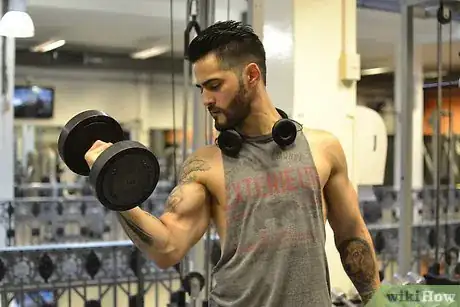
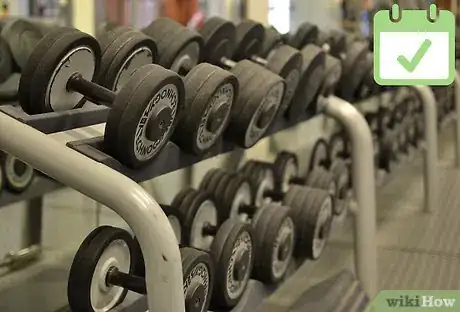
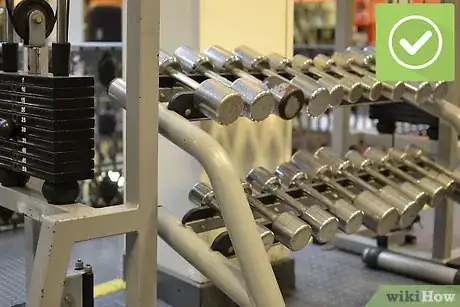


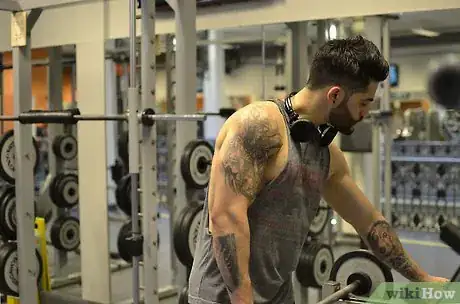

_sample.webp)
_sample.webp)
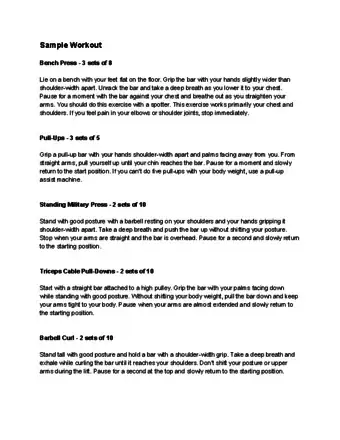


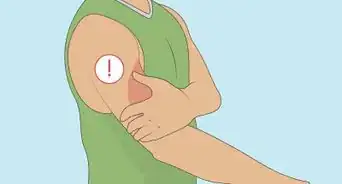

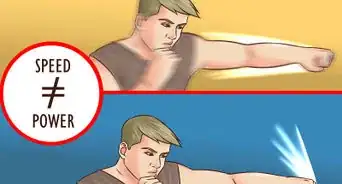
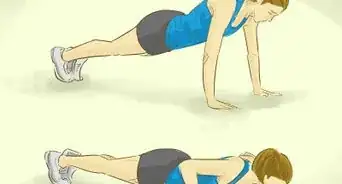
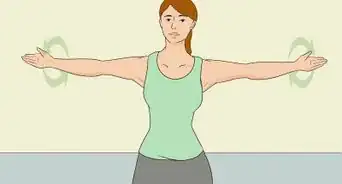
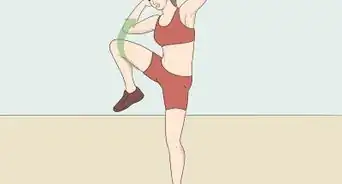
-Step-10-Version-5.webp)











